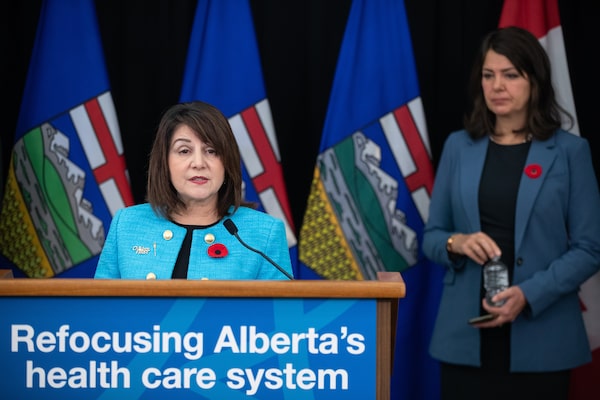
Adriana LaGrange, Alberta minister of health, speaks about health-care reforms as Premier Danielle Smith looks on during a news conference in Edmonton on Nov. 8, 2023.JASON FRANSON/The Canadian Press
Alberta must pay roughly $9.5-million in severance to health employees it terminated in the last fiscal year as part of the United Conservative Party’s campaign to overhaul the province’s medical system.
Alberta Health Services, in its compensation disclosure for the year ended March 31, said the seven senior executives the government let go last fall will collectively receive $5.22-million in severance. Alberta owes severance to a total of 33 former AHS employees who were let go last year, up from 23 the year prior.
Premier Danielle Smith, in the 2023 spring election and the 2022 UCP leadership contest, vowed to revamp AHS, eliminating what she perceived as a lethargic layer of middle managers and an ineffective executive. The government’s effort, spurred in part by Ms. Smith’s displeasure with the way health officials managed the coronavirus pandemic, has yet to produce tangible results for patients, although the tab is rising.
Alberta owes Mauro Chies, AHS’s former president and chief executive, $1.38-million in severance, according to the compensation disclosure for AHS, the organization that delivers the majority of health care in the province, and the 2023-24 annual report for Alberta Health, the government department.
Mr. Chies was terminated in November, after being appointed president and CEO in March, 2023, and serving as the interim boss since April, 2022. AHS will pay his salary until November, 2025, according to the terms of his severance package, disclosed in Alberta Health’s report.
François Bélanger, the former vice-president of quality and chief medical officer, received $1.07-million in severance, Alberta Health said.
The government spent more than $13.3-million on “health care system refocusing efforts” in the last fiscal year, according to Alberta Health’s annual report. The government did not respond to a question asking if that included severance payments. The annual report noted the refocusing work included town halls and reviewing “AHS’ key functions, accountabilities, and expenditures in order to determine its most appropriate alignment in the refocused system, including the transfer of some current AHS functions to the new sector-based health organizations.”
The UCP is in the midst of breaking up AHS into four parts: primary care, acute care, continuing care, and mental health and addictions. Recovery Alberta, which will assume responsibility for mental health and addictions, launched July 1 and transitions its operations this fall.
Ms. Smith, in November, 2022, installed John Cowell as AHS’s administrator, in lieu of a board. Ms. Smith empowered him to strengthen AHS, but he was replaced before the public could notice any major improvements and the government rolled out plans to create four new organizations.
He was paid $436,000 in fiscal 2024 and $267,000 the year prior. His tenure ended when Alberta announced a new board and swept out AHS’s senior executives in November.
Lyle Oberg, who was appointed chair as part of the autumn shakeup, was paid $155,000 in fiscal 2024, according to the annual report. The previous chair, who served between December, 2021, and November, 2022, received $43,000 in fiscal 2023, the report said. Alberta did not respond to questions about the compensation gap.
Alberta’s health care system, like those in other parts of the country, has been under pressure for years, exacerbated here as the government spars with health care professionals and the population skyrockets. Smaller emergency departments frequently close, temporarily unable to provide care because of staff shortages. Some cancer patients are struggling to get quick access to treatment, and earlier this year, the province briefly halted its participation in a national kidney-donation program because of a lack of anesthesiologists.
The wait time to see a physician in Alberta’s emergency departments reached 6.7 hours in 2023-24, up from 6.2 hours the year prior, the annual report said. Alberta attributed the longer wait to an increase in the number of patients with the “highest level of acuity that require aggressive interventions such as patients with cardiac arrest or major trauma.”
Total visits to Alberta’s emergency departments increased by 2 per cent, including a 13-per-cent increase in patients with the highest level of acuity, the report said.
Alberta counted 11,738 physicians registered in the province at the end of calendar 2023, a net gain of 331 or 2.9 per cent compared with a year prior, the report said. Alberta’s population hit 4.69 million at the end of last year, up 4 per cent from 4.51 million the year prior, according to Statistics Canada.
The province’s 39 chartered surgical facilities, which are privately owned operations where citizens receive care paid for by government, conducted about 62,400 surgeries in fiscal 2024, up from 47,400 the year prior. These facilities accounted for 20.5 per cent of publicly funded surgeries in Alberta, the report said, up from 16.2 per cent in 2022-23.
Editor’s note: A previous version of this article incorrectly stated there are 1,738 physicians registered in Alberta as of the end of 2023. The correct number is 11,738. This version has been updated.